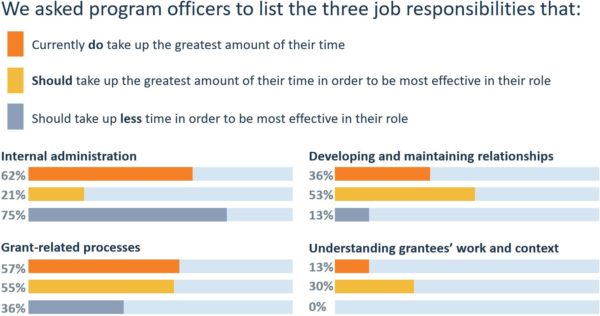Earlier this month, thanks to our generous host, Paul Hamlyn Foundation, CEP led a deep dive with 35 foundation leaders in the United Kingdom into what constitutes a strong funder–grantee relationship, the power dynamic that comes into play in them, and the crucial role of program officers to overcome it.
Drawing from key findings in Relationships Matter: Program Officers, Grantees, and the Keys to Success, we discussed how CEP defines relationships based on five questions asked in our grantee survey on fairness, responsiveness, approachability, and clarity and consistency of communications.
These aren’t easy to get right. Our research finds that it takes transparency and a deep understanding of grantees and the context in which they work. Having the opportunity to think through and discuss how different foundations with different approaches focus on those crucial concepts is always an exciting and generative experience.
Even when your grantees report highly positively on the quality of your relationships, it’s not always easy to tell what you’re doing differently that leads to this positive experience. This is what Amanda Beswick, director of the housing and homelessness program at Oak Foundation, said during the workshop, sharing that she builds relationships with grantees very organically, carefully adapting her approach based on grantees’ differing needs and preferences.
Yet prioritizing building relationships with grantees is tricky, as CEP’s Benchmarking Program Officer Roles and Responsibilities report shows. When surveyed for this research, a majority of program officers reported spending most of their time on internal administration and processes, and in contrast, desiring to spend most time on developing and maintaining relationships with grantees.

This tension came up during the workshop. “Building stronger relationships with grantees remains an ongoing challenge and journey,” said Régis Cochefert, director of grants and programmes at Paul Hamlyn Foundation, particularly when managing a large grantee portfolio including both individuals and organizations across a variety of programs and geographies. “We’re very intentional about the type of relationship we want to build with each grantee and try to set expectations very clearly upfront,” Régis said in response to a question about how his team manages their own capacity to build relationships.
We concluded the afternoon with each table picking one concrete challenge in building strong relationships with grantees and drawing from each other’s experience to solve it together. As each table reported out, one thing became clear: however straightforward the theory of building a strong funder-grantee relationship may sound, successfully bringing it into practice is far from it.
Charlotte Brugman is manager, assessment and advisory services, at CEP. To learn more about CEP’s workshops or about CEP’s work with international funders, please contact Charlotte at charlotteb@cep.org.



